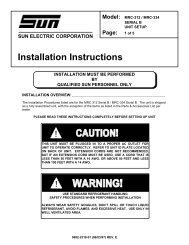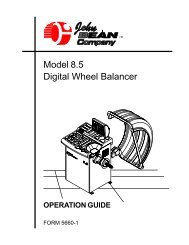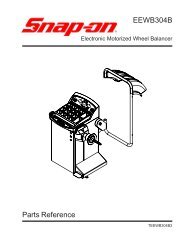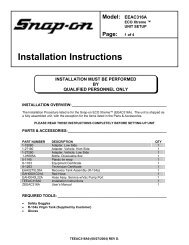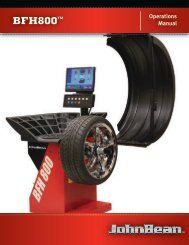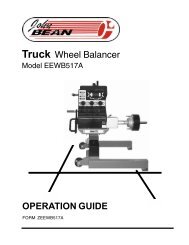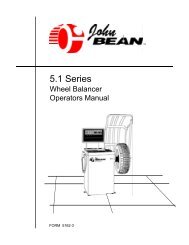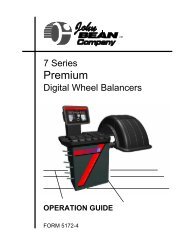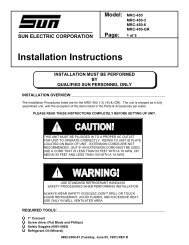Using this ManualSoftware License AgreementYOU SHOULD CAREFULLY READ THE FOLLOWING TERMS AND CONDITIONS BEFORE OPENING THIS SOFTWARE PACKAGE. WHOEVEROPENS THIS SOFTWARE PACKAGE MUST EITHER BE THE PERSON WHO ACQUIRED THE SOFTWARE OR A PERSON AUTHORIZED BYTHE PERSON OR ENTITY WHO ACQUIRED THE SOFTWARE TO ACCEPT THE FOLLOWING TERMS ON SUCH PERSON’S OR ENTITY’SBEHALF. “YOU” AND “YOUR” SHALL REFER TO THE PERSON OR ENTITY WHO ACQUIRED THIS PRODUCT. IF YOU DO NOT AGREE WITHTHEM, YOU SHOULD PROMPTLY RETURN THE PACKAGE UNOPENED TO THE PLACE OF PURCHASE FOR A FULL REFUND.LICENSE. Up<strong>on</strong> your acceptance of this License Agreement (the “Agreement”), <str<strong>on</strong>g>Snap</str<strong>on</strong>g>-<strong>on</strong> Tool Company LLC grants to the pers<strong>on</strong> or business entitywho originally acquired the Software a n<strong>on</strong>-exclusive license to use the Software subject to the terms and c<strong>on</strong>diti<strong>on</strong>s of this Agreement. The Softwarein this package is a proprietary product of <str<strong>on</strong>g>Snap</str<strong>on</strong>g>-<strong>on</strong> Diagnostics and is protected by copyright law, as well as other intellectual property laws. <str<strong>on</strong>g>Snap</str<strong>on</strong>g>-<strong>on</strong>Diagnostics retains title and ownership of the Software and it is being licensed to you and not sold. All rights not expressly granted to you are reservedby <str<strong>on</strong>g>Snap</str<strong>on</strong>g>-<strong>on</strong> Diagnostics. PERMITTED USES. YOU MAY: (i) install the Software <strong>on</strong> a single automotive diagnostic computer provided you keep theoriginal solely for backup or archival purposes. (ii) transfer the Software and License to another party if the other party agrees to accept the terms andc<strong>on</strong>diti<strong>on</strong>s of this Agreement, you retain no copies of the Software, and you transfer all of the Software.PROHIBITED USES. YOU MAY NOT: (i). copy the Software into any machine readable or printed form for backup or archival purposes. (ii) Modify,merge, translate, decompile, reverse engineer, disassemble, decode, or otherwise alter or attempt to derive the source code of the Software, exceptand <strong>on</strong>ly to the extent such activity is expressly permitted by applicable law notwithstanding this limitati<strong>on</strong>. (iii) use the Software <strong>on</strong> more than <strong>on</strong>ediagnostic computer at the same time. (iv) separate the Software’s comp<strong>on</strong>ent parts for use <strong>on</strong> more than <strong>on</strong>e computer. (v) transfer, assign, rent,lease, sell, or otherwise dispose of the Software <strong>on</strong> temporary or permanent basis except as expressly provided herein.TERM. The license is effective until terminated. You may terminate it any other time by destroying the Software. It will also terminate automatically withoutnotice from <str<strong>on</strong>g>Snap</str<strong>on</strong>g>-<strong>on</strong> Diagnostics if you fail to comply with any provisi<strong>on</strong> of this Agreement. You agree up<strong>on</strong> such terminati<strong>on</strong> to destroy the Software.LIMITED WARRANTY. <str<strong>on</strong>g>Snap</str<strong>on</strong>g>-<strong>on</strong> Diagnostics warrants the disk or other media (the “disk”) <strong>on</strong> which the Software is furnished to be (i) free from defectsin materials and workmanship and (ii) will perform substantially in accordance with the accompanying packaging and documentati<strong>on</strong>, under normaluse for a period of sixty (60) days from the date of delivery to you as evidenced by a copy of your sales receipt. THIS LIMITED WARRANTY ISPROVIDED IN LIEU OF ANY OTHER EXPRESS WARRANTIES (IF ANY), ALL OF WHICH ARE DISCLAIMED BELOW. THIS LIMITED WARRANTYIS THE ONLY EXPRESS WARRANTY THAT IS PROVIDED TO YOU.WARRANTY DISCLAIMER. EXCEPT AS SET FORTH IN THE ABOVE LIMITED WARRANTY AND TO THE MAXIMUM EXTENT PERMITTED BYAPPLICABLE LAW, THE SOFTWARE IS PROVIDED “AS IS”, WITH ALL FAULTS AND WITHOUT WARRANTY, EITHER EXPRESS, IMPLIED ORSTATUTORY, INCLUDING, BUT NOT LIMITED TO THE IMPLIED WARRANTIES OF MERCHANTABILITY AND FITNESS FOR A PARTICULARPURPOSE, OF LACK OF VIRUSES, AND OF LACK OF NEGLIGENCE OR LACK OF WORKMANLIKE EFFORT AND ALL SUCH WARRANTIESARE HEREBY EXPRESSLY DISCLAIMED. SNAP-ON DIAGNOSTICS DOES NOT WARRANT, GUARANTEE, OR MAKE ANY REPRESENTATIONSREGARDING THE USE, OR THE RESULTS OF THE USE, OF THE SOFTWARE OR WRITTEN MATERIALS IN TERMS OF CORRECTNESS,ACCURACY, RELIABILITY, CURRENTNESS, OR IN TERMS OF YOUR REQUIREMENTS. ALSO, THERE IS NO WARRANTY OF TITLE ORNONINFRINGEMENT IN THE SOFTWARE. NO ORAL OR WRITTEN INFORMATION OR ADVICE GIVEN BY SNAP-ON DIAGNOSTICS, ITSAGENTS, OR EMPLOYEES SHALL CREATE A WARRANTY OR IN ANY WAY INCREASE THE SCOPE OF THIS WARRANTY, AND YOU MAY NOTRELY ON ANY SUCH INFORMATION OR ADVICE.YOUR EXCLUSIVE REMEDY. <str<strong>on</strong>g>Snap</str<strong>on</strong>g>-<strong>on</strong> Diagnostics entire liability and your exclusive remedy as to the Software (including without limitati<strong>on</strong>, thedisks) shall be, at <str<strong>on</strong>g>Snap</str<strong>on</strong>g>-<strong>on</strong> Diagnostics’ opti<strong>on</strong>, either (i) the return of the price paid (if any) for, or (ii) the repair or replacement at no charge of, anydisk not meeting this Limited Warranty and which is returned to <str<strong>on</strong>g>Snap</str<strong>on</strong>g>-<strong>on</strong> Diagnostics at your expense with a copy of the sales receipt. If failure of thedisk has resulted from accident, abuse or misapplicati<strong>on</strong>, <str<strong>on</strong>g>Snap</str<strong>on</strong>g>-<strong>on</strong> Diagnostics shall replace the damaged disk <strong>on</strong> an as-available basis, up<strong>on</strong> return ofthe old disk and a replacement fee. Any replacement Software will be warranted for the remainder of the original warranty period of thirty (30) days,whichever is l<strong>on</strong>ger.EXCLUSION OF CONSEQUENTIAL, INCIDENTAL AND CERTAIN OTHER DAMAGES. TO THE MAXIMUM EXTENT PERMITTED BYAPPLICABLE LAW, NEITHER SNAP-ON DIAGNOSTICS NOR ANY ONE ELSE WHO HAS BEEN INVOLVED IN THE CREATION, PRODUCTION,OR DELIVERY OF THE SOFTWARE SHALL BE LIABLE TO YOU FOR ANY INDIRECT, CONSEQUENTIAL, INCIDENTAL OR PUNITIVE DAMAGESWHATSOEVER (INCLUDING BUT NOT LIMITED TO DAMAGES FOR LOSS OF BUSINESS OR PERSONAL PROFITS, BUSINESSINTERRUPTION, LOSS OF BUSINESS OR PERSONAL OR CONFIDENTIAL INFORMATION, OR ANY OTHER PECUNIARY LOSS, DAMAGESFOR LOSS OF PRIVACY, OR FOR FAILURE TO MEET ANY DUTY, INCLUDING ANY DUTY OF GOOD FAITH OR TO EXERCISE COMMERICALLYREASONABLE CARE OR FOR NEGLIGENCE) ARISING OUT OF OR IN ANY WAY RELATED TO THE USE OR INABILITY TO USE SUCHSOFTWARE, EVEN IF SNAP-ON DIAGNOSTICS HAS BEEN ADVISED OF THE POSSIBILITY OF SUCH DAMAGES. Some states/jurisdicti<strong>on</strong>s d<strong>on</strong>ot allow the exclusi<strong>on</strong> or limitati<strong>on</strong> of incidental or c<strong>on</strong>sequential damages, so the above limitati<strong>on</strong> or exclusi<strong>on</strong> may not apply to you.GENERAL. This Agreement will be governed by the laws of the State of Illinois. You acknowledge that you have read this Agreement, understand itand agree to be bound by its terms and c<strong>on</strong>diti<strong>on</strong>s. You further agree that it is the complete and exclusive statement of the Agreement between youand <str<strong>on</strong>g>Snap</str<strong>on</strong>g>-<strong>on</strong> Diagnostics which supersedes any proposal or prior agreement, oral or written, and any other communicati<strong>on</strong>s between you and <str<strong>on</strong>g>Snap</str<strong>on</strong>g><strong>on</strong>Diagnostics relating to the subject of this Agreement. Should you have any questi<strong>on</strong>s c<strong>on</strong>cerning this Agreement, you may c<strong>on</strong>tact <str<strong>on</strong>g>Snap</str<strong>on</strong>g>-OnDiagnostics, 420 Barclay Blvd., Lincolnshire, Illinois 60069.viii
Safety Informati<strong>on</strong>For your safety, read this manual thoroughly before operating the Flexible GasAnalyzer.The Flexible Gas Analyzer is intended for use by properly trained, skilledprofessi<strong>on</strong>al automotive technicians. The safety messages presented in thissecti<strong>on</strong> and throughout this manual are reminders to the operator to exerciseextreme care when using this test instrument.There are many variati<strong>on</strong>s in procedures, techniques, tools and parts for servicingvehicles, as well as in the skill of the individual doing the work. Because of the vastnumber of test applicati<strong>on</strong>s and variati<strong>on</strong>s in the products that can be tested withthis instrument, the manufacturer cannot possibly anticipate or provide advice orsafety messages to cover every situati<strong>on</strong>. It is the automotive technician'sresp<strong>on</strong>sibility to be knowledgeable of the system that is to be tested. It is essentialto use proper service methods and test procedures and to perform tests in anappropriate and acceptable manner that does not endanger your safety, the safetyof others in the work area or the equipment or vehicle being tested.It is assumed that, before using this tool, the operator has a thoroughunderstanding of vehicle systems. Understanding the principles and operatingtheories of vehicle systems is necessary for competent, safe and accurate use.Before using the Flexible Gas Analyzer, always refer to and follow the safetymessages and applicable test procedures provided by the manufacturer of theequipment or vehicle being tested.Read All <str<strong>on</strong>g>Instructi<strong>on</strong>s</str<strong>on</strong>g>Read all instructi<strong>on</strong>s and safety messages in this manual. All safety messages inthis secti<strong>on</strong> c<strong>on</strong>tain a signal word, a three-part message, and, in some instances,a symbol/pictorial.The signal word indicates the level of hazard in a situati<strong>on</strong>.• Danger indicates an imminently hazardous situati<strong>on</strong> which, if not avoided, willresult in death or serious injury to the operator or bystanders.• Warning indicates a potentially hazardous situati<strong>on</strong> which, if not avoided, couldresult in death or serious injury to the operator or bystanders.• Cauti<strong>on</strong> indicates a potentially hazardous situati<strong>on</strong> which, if not avoided, mayresult in moderate or minor injury to the operator or bystanders.Safety messages in this secti<strong>on</strong> c<strong>on</strong>tain three different type styles.• Normal type states the hazard.• Bold type states how to avoid the hazard.• Italic type states the possible c<strong>on</strong>sequences of not avoiding the hazard.An ic<strong>on</strong>, when present, gives a graphical descripti<strong>on</strong> of the potential hazard.I



